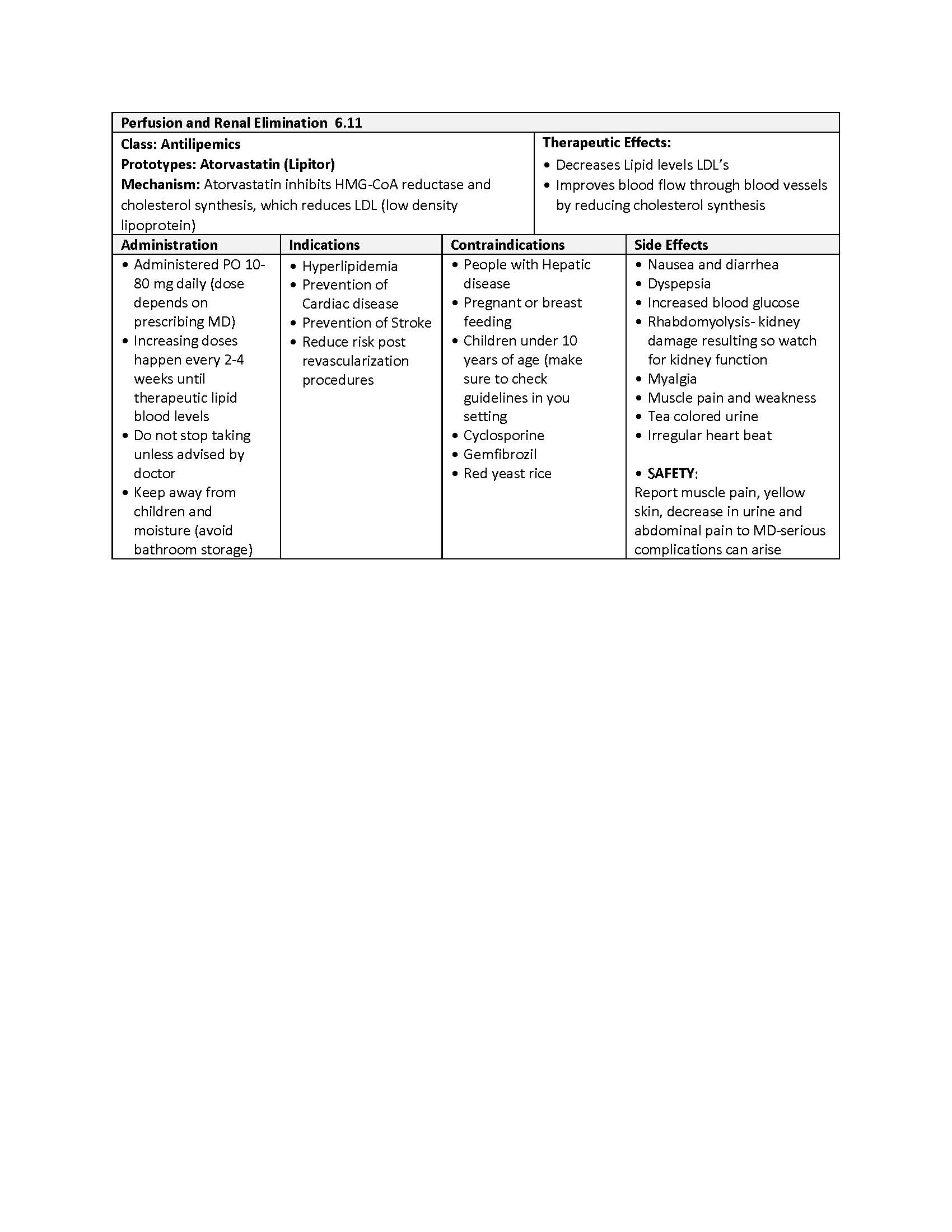Perfusion and Renal Elimination
6.11 Antilipemics
Open Resources for Nursing (Open RN)
Antilipemic Medications
Antilipemic agents reduce hyperlipidemia that may lead to additional health problems such as stroke, myocardial infarction, angina, and heart failure. Medications should be used in adjunct with a healthy diet and exercise regime approved by the client’s health care provider.
Ezetimibe
Mechanism of Action
Ezetimibe blocks the absorption of cholesterol in the small intestines to reduce LDL.
Indications for Use
This medication is used for treatment of hyperlipidemia and familial hypercholesterolemia.
Nursing Considerations Across the Lifespan
If medication is combined with HMG-CoA reductase inhibitors, do not give to pregnant or breastfeeding clients.
Adverse/Side Effects
Use with caution when ezetimibe is combined with additional medication. Clients may experience arthralgia, rhabdomyolysis, hepatic impairment, dizziness, upper respiratory infections, or diarrhea if they are taking this medication. Minimal side effects were reported with monotherapy.[1]
Client Teaching & Education
Clients should take the prescribed medication as directed and avoid consuming grapefruit juice during drug therapy. The medication should be used with dietary modifications. If the client experiences muscle pain, tenderness, or weakness, this should be reported to the healthcare provider.[2]
Atorvastatin
Mechanism of Action
Atorvastatin inhibits HMG-CoA reductase and cholesterol synthesis, which reduces LDL (low density lipoprotein).
Indications for Use
This medication is used for hyperlipidemia and the prevention of cardiovascular disease.
Nursing Considerations Across the Lifespan
Do not use with clients who have hepatic disease.
This medication is contraindicated with clients who are pregnant or breastfeeding. Do not give to clients under 10 years of age.
Use caution with geriatric clients due to increased risk for myopathy.
Adverse/Side Effects
Clients who are pregnant or breastfeeding should not take this medication. A health care provider will assess routine liver function for a client taking atorvastatin. Nausea, diarrhea, dyspepsia, increase in blood glucose, rhabdomyolysis, myalgia, or muscle spasms may be produced by taking this medication. Rhabdomyolysis is a condition in which damaged skeletal muscle breaks down rapidly, causing muscle pain and weakness. Some of the muscle breakdown products are harmful to the kidneys and can cause kidney failure. There may be tea-colored urine or an irregular heartbeat with rhabdomyolysis. [3]
Client Teaching & Education
Clients should take the prescribed medication as directed and avoid consuming grapefruit juice during drug therapy. The medication should be used with dietary modifications. If the client experiences muscle pain, tenderness, or weakness, these should be reported to the healthcare provider.[4]
Now let’s take a closer look at the medication grid on atorvastatin in Table 6.11.[5]

Media Attributions
- Lipitor
- This work is a derivative of Daily Med by U.S. National Library of Medicine in the public domain. ↵
- uCentral from Unbound Medicine. https://www.unboundmedicine.com/ucentral ↵
- This work is a derivative of Daily Med by U.S. National Library of Medicine in the public domain. ↵
- uCentral from Unbound Medicine. https://www.unboundmedicine.com/ucentral ↵
- This work is a derivative of Daily Med by U.S. National Library of Medicine in the public domain. ↵

